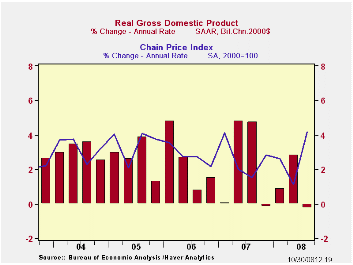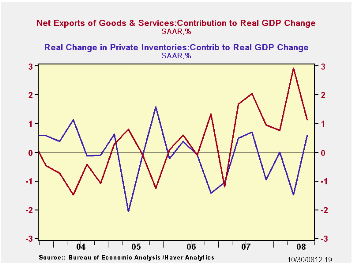 Global| Oct 30 2008
Global| Oct 30 2008U.S. 3Q'08 GDP Fell Modestly
by:Tom Moeller
|in:Economy in Brief
Summary
U.S. real GDP fell a modest 0.3% (AR) last quarter after 2.8% growth during 2Q. Consensus expectations had been for a decline at a 0.5% rate. The decline last quarter mirrored a 0.2% decline during the fourth quarter of last year. The [...]


Real personal consumption declined at a 3.1% (0.0% y/y) annual rate, reversing a 1.2% rise during 2Q. The 2Q gain presumably was fueled by tax rebate checks but the lift seems to have been slight. Spending on autos & light trucks fell at a 25.6% (-14.7% y/y) annual rate after declining at a 19.7% rate during 2Q. Spending on furniture & other household equipment fell at a 7.6% rate (+2.7% y/y) and the decline reversed roughly half of the 2Q increase. Spending on apparel fell at an 11.0% rate (-0.4% y/y) and that reversed all of the 2Q jump. Spending on consumer services also weakened to a 0.6% growth rate. That about matched the 2Q rise but the y/y change of 1.3% was the weakest since 1981. Growth in real PCE subtracted 2.3 percentage points from 3Q real GDP growth after a 0.9 point add during 2Q.
Residential construction fell again, last quarter at a 19.1% (-21.3% y/y) annual rate after a 13.3% rate of decline during 2Q. The 3Q drop subtracted 0.7 percentage points from GDP growth. Growth in business fixed investment fell for the first time since fourth quarter, 2006. The 1.0% decline (+1.8% y/y) followed 2.5% growth during 2Q, a 4.9% rise during 2007 and roughly 7.5% growth in 2006 and 2005. Equipment investment repeated its 2Q performance and declined at a 5.5% rate (-2.6% y/y). Conversely, structures investment was firm again and rose at a 7.9% annual rate (10.8% y/y). An improved foreign trade deficit again was the main source of lift to GDP growth, though the 1.1 percentage point addition was almost a third of that in 2Q. Exports grew at a slower 5.9% rate (6.9% y/y), half that in 2Q. Growth in imports weakened with the slowdown in overall economic growth. They fell at a 1.9% rate (-3.1% y/y).
An improved foreign trade deficit again was the main source of lift to GDP growth, though the 1.1 percentage point addition was almost a third of that in 2Q. Exports grew at a slower 5.9% rate (6.9% y/y), half that in 2Q. Growth in imports weakened with the slowdown in overall economic growth. They fell at a 1.9% rate (-3.1% y/y).
Inventory accumulation added 0.6 percentage points to GDP growth after three consecutive quarters of subtraction.
Spending by governments was strong again and the 5.8% (3.1% y/y) rise was the quickest since early 2003.
The GDP chain price index surged at a 4.2% annual rate. The accelerated rate of increase owed to a 5.4% jump in the PCE price index which was fueled by higher energy prices. Capital spending prices rose at an accelerated 4.2% rate (2.2% y/y) while the residential investment price deflator declined for the fourth straight quarter (-1.8% y/y).
Fed, Central Banks in Brazil, Mexico, Korea and Singapore, Announce Swap Lines and the Fed's announcement can be found here.
| Chained 2000$, % AR | 3Q '08 (Advance) | 2Q '08 | 3Q Y/Y | 2007 | 2006 | 2005 |
|---|---|---|---|---|---|---|
| GDP | -0.3 | 2.8 | 0.8 | 2.0 | 2.8 | 2.9 |
| Inventory Effect | 0.6 | -1.5 | -0.4 | -0.4 | 0.0 | -0.2 |
| Final Sales | -0.8 | 4.4 | 1.3 | 2.4 | 2.8 | 3.1 |
| Foreign Trade Effect | 1.1 | 2.9 | 1.7 | 0.6 | 0.2 | 0.0 |
| Domestic Final Demand | -1.8 | 1.3 | -0.1 | 1.8 | 2.6 | 3.1 |
| Chained GDP Price Index | 4.2 | 1.1 | 2.7 | 2.7 | 3.2 | 3.3 |
Tom Moeller
AuthorMore in Author Profile »Prior to joining Haver Analytics in 2000, Mr. Moeller worked as the Economist at Chancellor Capital Management from 1985 to 1999. There, he developed comprehensive economic forecasts and interpreted economic data for equity and fixed income portfolio managers. Also at Chancellor, Mr. Moeller worked as an equity analyst and was responsible for researching and rating companies in the economically sensitive automobile and housing industries for investment in Chancellor’s equity portfolio. Prior to joining Chancellor, Mr. Moeller was an Economist at Citibank from 1979 to 1984. He also analyzed pricing behavior in the metals industry for the Council on Wage and Price Stability in Washington, D.C. In 1999, Mr. Moeller received the award for most accurate forecast from the Forecasters' Club of New York. From 1990 to 1992 he was President of the New York Association for Business Economists. Mr. Moeller earned an M.B.A. in Finance from Fordham University, where he graduated in 1987. He holds a Bachelor of Arts in Economics from George Washington University.






